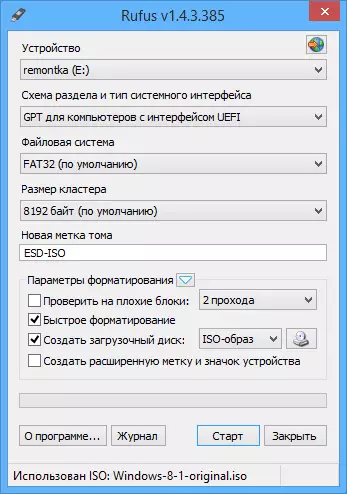
In this material it will be clearly shown exactly how to use this program and briefly described why in some cases its use will be preferable than the performance of the same tasks using WinsetUpFromusb, Ultraiso or other similar software. Additionally: UEFI bootable flash drive on the Windows command prompt.
Update 2018: The version of RUFUS 3.0 came out (I recommend to familiarize the new instruction)
Advantages of RUFUS.
The benefits of this, relatively little known, the programs can be attributed:- It is free and does not require installation, while "weighs" about 600 KB (current version 1.4.3)
- Full UEFI and GPT support for the loading flash drive (you can make a bootable USB flash drive 8.1 and 8)
- Creating a DOS bootable flash drive, installation drives from the ISO image of Windows and Linux
- High speed (according to the developer application, USB with Windows 7 is created twice as fast as using Windows 7 USB / DVD Download Tool from Microsoft
- Including in Russian
- Easy use
In general, let's see how the program works.
Note: To create a UEFI boot flash drive with GPT partition scheme, it is necessary to produce it in Windows Vista and later versions of the operating system. In Windows XP, it is possible to create a UEFI boot drive with MBR.
How to make a UEFI bootable flash drive in rufus
Download the latest version of RUFUS you can download free from the official website of the developer https://rufus.ie
As mentioned above, the program does not require installation: it will start with the interface in the operating system language and its main window looks like in the picture below.

All fields to fill out do not require special explanations, you need to specify:
- Device - Future boot flash drive
- Scheme of the section and type of system interface - in our case GPT with UEFI
- File system and other formatting parameters
- In the "Create a boot disk" field, click on the disk icon and specify the path to the ISO image, I try with the original way Windows 8.1
- The "Create Extended Label and Device Icon" mark adds the device icon and other information to the autorun.inf file on the flash drive.

After all the parameters are specified, click the "Start" button and expect until the program prepare the file system and does not copy files to the USB flash drive with the GPT section for UEFI. I can say that this is really quite quickly in comparison with what had to be observed when using other programs: Feelings, the speed of the approximate is equal to the transfer rate of USB files.
If you have any questions on the use of RUFUS, as well as the additional features of the program, I recommend to see the FAQ section, the link to which you will find on the official website.
